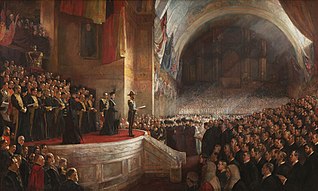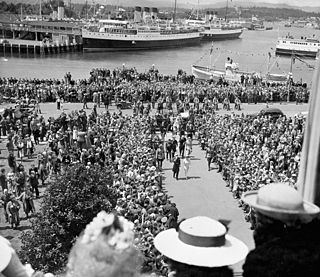
The monarchy of New Zealand is the constitutional system of government in which a hereditary monarch is the sovereign and head of state of New Zealand. The current monarch, King Charles III, acceded to the throne following the death of his mother, Queen Elizabeth II, on 8 September 2022 in the United Kingdom. The King's elder son, William, Prince of Wales, is the heir apparent.

Sir Neil Elliott Lewis, Australian politician, was Premier of Tasmania on three occasions. He was also a member of the first Australian federal ministry, led by Edmund Barton.
The Limelight Department was one of the world's first film studios, beginning in 1898, operated by The Salvation Army in Melbourne, Australia. The Limelight Department produced evangelistic material for use by the Salvation Army, including lantern slides as early as 1891, as well as private and government contracts. In its 19 years of operation, the Limelight Department produced about 300 films of various lengths, making it one of largest film producers of its time.
The following lists events that happened during 1901 in Australia.
Events from the year 1901 in the United Kingdom. This year marks the transition from the Victorian to the Edwardian era, with the death of the 81-year-old Queen and the accession of her 59-year-old son.

Since 1867, the British royal family has visited Australia over fifty times, with only six visits before 1954. Elizabeth II is the first and only reigning monarch of Australia to have set foot on Australian soil; she first did so on 3 February 1954, when she was 27 years old. During her sixteen journeys, the Queen visited every Australian state and the two major territories.

HMS Royal Arthur was a first class cruiser of the Edgar class, previously named Centaur, but renamed in 1890 prior to launching. She served on the Australia Station and briefly on the North America and West Indies Station before returning to the Home Fleet in 1906. She was paid off after the First World War.

RMS Ophir was an Orient Steam Navigation Company steam ocean liner that was built in 1891 and scrapped in 1922. Her regular route was between London and Sydney via the Suez Canal, Colombo and Melbourne.

The monarchy of Papua New Guinea is a system of government in which a hereditary monarch is the sovereign and head of state of Papua New Guinea. The current Papua New Guinean monarch and head of state, since 8 September 2022, is King Charles III. As sovereign, he is the personal embodiment of the Papua New Guinean Crown. Although the person of the sovereign is equally shared with 14 other independent countries within the Commonwealth of Nations, each country's monarchy is separate and legally distinct. As a result, the current monarch is officially titled King of Papua New Guinea and, in this capacity, he and other members of the royal family undertake public and private functions domestically and abroad as representatives of Papua New Guinea. However, the King is the only member of the royal family with any constitutional role.
Australia is a constitutional monarchy whose Sovereign also serves as Monarch of the United Kingdom, New Zealand, Canada and eleven other former dependencies of the United Kingdom including Papua New Guinea, which was formerly a dependency of Australia. These countries operate as independent nations, and are known as Commonwealth realms. The history of the Australian monarchy has involved a shifting relationship with both the monarch and also the British government.

The Opening of the First Parliament of the Commonwealth of Australia by H.R.H. The Duke of Cornwall and York, May 9, 1901, more commonly known in Australia as The Big Picture, is a 1903 painting by the Australian artist Tom Roberts. The painting, measuring 304.5 by 509.2 centimetres, or roughly 10 by 17 feet, depicts the opening of the first Parliament of Australia at the Royal Exhibition Building in Melbourne on 9 May 1901.

Since 1786, members of the Canadian royal family have visited Canada, either as an official tour, a working tour, a vacation, or a period of military service. The first member to visit was the future King William IV in 1786. In 1939, King George VI became the first reigning monarch to tour the country.

The Barton government was the first federal executive government of the Commonwealth of Australia. It was led by Prime Minister Sir Edmund Barton, from 1 January 1901 until 24 September 1903, when Barton resigned to become one of the three founding judges of the High Court of Australia.

HMS Diana was an Eclipse-class protected cruiser built for the Royal Navy in the mid-1890s.

Inauguration of the Commonwealth was a 1901 Australian documentary film commissioned by the Governments of New South Wales and Victoria to record the inaugural day of the Federation of Australia.

Joseph Henry Perry was an English-born New Zealander and Australian cinematographer, entrepreneur and Salvation Army officer. Born to Joseph Perry Sr. and Eliza Hall, his sons Orizaba, Reginald and Stanley also went on to have careers in the Australian film industry.
Royal visits to New Zealand by members of the Royal Family have been taking place since 1869. The first member of the Royal Family to visit New Zealand was Prince Alfred, Duke of Edinburgh. Subsequently, there have been over 50 visits. The first reigning monarch of New Zealand to visit the country was Elizabeth II in 1953–54. In all, she visited New Zealand on 10 occasions, most recently in 2002.

The Ruby Jubilee of Elizabeth II in 1992 marked the 40th anniversary of the accession of Queen Elizabeth II on 6 February 1952. Contrary to her Silver Jubilee in 1977, it was not regarded as an "official" jubilee. However, the milestone was marked with a number of events and community projects.
Royal Visit of the Duke and Duchess of Cornwall and York to New Zealand was a 1901 New Zealand silent documentary film made by the Limelight Department of the Salvation Army in Australia.












